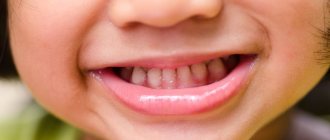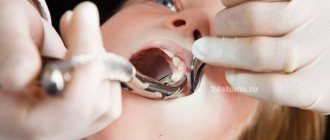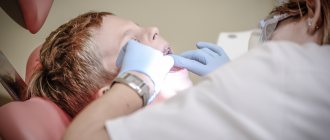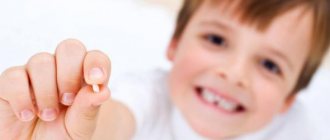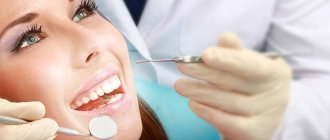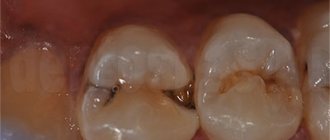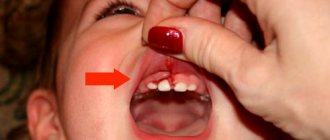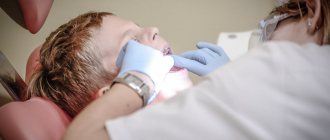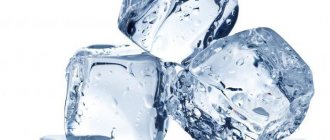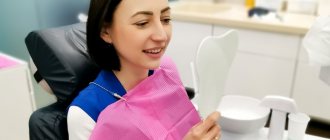- What to do if a child breaks a tooth?
- A child's tooth is dislocated.
- If a child knocks out a baby tooth, what should you do?
- Prevention of childhood dental injuries.
Children differ from adults by being more active and playful.
These properties allow them to quickly understand the world around them. But sometimes children's pranks lead to unpleasant consequences, such as a knocked out or chipped tooth. Injuries to the dentition can occur either due to negligence or as a result of weakening of the enamel. Whatever the reason, parents urgently need to solve this problem.
And the only sure way to avoid complications after a chipped tooth is to see a dentist.
What to do if a child breaks a tooth?
The first thing to do is to calm the child and examine for other injuries that require urgent medical attention. If these are not observed, then rinse your baby’s mouth with water, blot the injury site with a clean napkin, and also try to find the chipped part of the tooth.
If the pain is severe, the child should be given a pain reliever. If a red dot is visible on the tooth, this means that the nerve has been exposed. In this case, you should not give your child cold or hot drinks and go to the dentist as soon as possible.
If there is no red dot on the damaged tooth, it has not moved, and the jaw can close normally, then there is no particular danger. Nevertheless, it is still necessary to see a doctor, since the tooth has lost its protective layer and is now more susceptible to infections and all kinds of diseases. Without proper treatment, the nerve may simply die, resulting in the loss of the entire tooth.
Doctor's actions in the clinic
If the parents manage to bring in a broken tooth, the dentist performs hygienic treatment of the oral cavity, puts the tooth in its original place and fixes it. If a tooth is missing, cosmetic restoration is performed using photocomposite materials, a crown or a prosthesis, which replace the missing part of the tooth. When the child grows up and reaches adulthood, dental implantation can be performed.
Pediatric dentists at our clinic are professionals in aesthetic restoration of children's teeth. We carry out procedures taking into account the structural features of the child’s jaw, so that in the future it will form correctly. Thanks to the latest dental equipment of the clinic, we can restore teeth that have been destroyed almost below the gums - so that the new ones are indistinguishable from the real ones.
Tooth dislocation in a child
Tooth luxation is a displacement of the crown in its alveolus as a result of physical impact. This injury is especially common in children and is common among all types of dental injuries. Symptoms of a dislocation may include:
- displacement of the dental crown back, forward, sideways
- the tooth is rotated around its axis
- the child cannot close his jaw completely
- tooth tissues are separated from the gums
- the soft tissue around the tooth swells and bleeds
- the tooth is loose, but still stays in the socket
It is imperative to see a dentist, even if the tooth looks almost undamaged. There may be a broken root or damaged nerve inside it. Such a tooth can be saved, the main thing is not to put pressure on it and not to self-medicate.
Only a qualified dentist can correctly assess the damage and prescribe effective treatment. If you see a doctor within the next hour after receiving an injury, the chances of saving the tooth increase significantly.
Tooth fracture - symptoms and treatment
Transverse (horizontal) fracture
In case of a fracture of the crown part of the tooth without damage to the pulp, caries may develop in the absence of treatment and subsequently pulpitis and periodontitis. In case of a fracture accompanied by exposure of the pulp, acute pulpitis is a complication. The occurrence of pulpitis is accompanied by pronounced pain in the area of the causative tooth with irradiation (spread) along the branch of the trigeminal nerve to the area of neighboring teeth or antagonist teeth. The pain mainly occurs at night. Without appropriate treatment, acute pulpitis can turn into chronic pulpitis, and later into periodontitis, characterized by the symptom of an “overgrown tooth” (the feeling that a tooth has come out; you cannot bite on it, as it causes pain). You can clearly identify the causative tooth by performing percussion - tapping on the tooth. Pain also occurs when eating hot food.
In the absence of treatment, after some time the process of pulp sclerosis begins - degeneration, pulp atrophy, its replacement with connective tissue. As a rule, there is no acute pain at this stage, but chronic inflammatory processes - osteitis or radicular cysts - begin to develop in the bone surrounding the tooth.
Vertical tooth fracture
This injury is incompatible with the continued existence of this tooth in the alveolus. Without treatment (in this case it involves tooth extraction), the situation leads to the rapid development of an inflammatory local process - dental periodontitis, which can later develop into periostitis (inflammation of the periosteum), osteomyelitis (chronic inflammation of the bone, which leads to resorption of bone tissue in the area of the lesion). ) and into extensive inflammation of soft tissues - an abscess of the maxillofacial area.
In this case, a purulent infiltrate appears around the tooth, melting the surrounding tissue. The patient's general condition worsens, the temperature rises, and swelling of the buccal or submandibular area occurs. Without appropriate treatment (tooth extraction, opening of periostitis or abscess), the process quickly becomes diffuse. In this case, phlegmon of the soft tissues of the face and neck may occur. Such a rapid and dangerous course of inflammatory processes in the oral cavity is due to the structural features of the cellular spaces of the face and neck. Cellular spaces are located between the muscle fascia. They are loose connective tissue. A distinctive feature of this tissue is the rapid development of purulent inflammation in it, which then spreads to nearby muscles and tendons.
Complications of a fracture also include resorption (external and internal) of the tooth root after injury. It appears after a few months. Resorption can be in the area of the apex (apex) of the root or in the area of the tooth root fracture. It occurs due to the lack of a “replacement callus”, which should restore the tissues of the tooth root - dentin and cement. The symptoms are quite sparse. This may be tooth mobility or pain when biting on a tooth. As a rule, it is possible to clearly diagnose resorption after an X-ray examination. This situation is a late complication of a tooth fracture. The tooth must be removed [9].
If a child knocks out a baby tooth, what should you do?
In the case of baby teeth, we are not talking about restoring them or putting them back. It is not necessary to look for the knocked-out fragment. But it is necessary to take care of the molar tooth germ, which is located in the gum. You cannot injure it or allow it to get infected, so a visit to the dentist is mandatory.
If the baby accidentally knocks out a molar, it must be found and returned to the socket as quickly as possible. In this case, the tooth should be washed in saline solution or plain water, and also held by the crown part so as not to cause an infection.
The best and most predictable option is to return the tooth to the socket within the first 15 minutes. This increases the chance of its recovery to 90%. If you are afraid to insert a tooth yourself, then you should see a doctor as soon as possible.
In this case, the tooth must be transported in a suitable environment - saline solution, milk, water.
Damage to hard dental tissues
- Ifraction of enamel. It is a crack on the surface of the tooth without loss of dental tissue.
- Fracture within the enamel. Belongs to the category of chips without complications, but with the loss of some tissue.
- Enamel-dentin fracture. The fracture has no complications, and is distinguished by the passage of the chip line simultaneously along the enamel and dentin. Part of the dental tissue is lost.
- Enamel-dentin-pulp fracture. Refers to the number of fractures with complications, which result in exposure of the pulp.
Prevention of childhood dental injuries
In order not to encounter the situations described above, you should take care in advance of the safety of the baby’s oral cavity. Remember that some dental injuries can be prevented by using simple protective measures:
- An excellent protection against injury during active games or sports is a helmet that not only protects the head, but also the teeth.
- To protect your child's teeth, use a mouthguard. This simple dental product provides as much as 85% protection.
- Talk to your children about the importance of being careful when playing. But don't intimidate them.
- Teach your child to fall without injury. Demonstrate how to tuck to avoid head and neck injuries.
- Provide your baby with healthy nutrition with all the necessary vitamins and microelements.
- Teach your child to brush their teeth regularly and visit the dentist every six months.
If you still failed to protect your baby from injury, you should contact your dentist as soon as possible. You can get qualified help at Aesculapius dentistry. In our dentistry you will find first-class equipment and modern treatment methods.
Four specialists work in one shift and they know their job very well. We work with each patient on an individual basis and provide a guarantee for all services. Absolutely all clients are satisfied with the level of service.
Causes
The reasons why a child breaks a permanent tooth are most often blows to the face or falls. An accident can occur during sports, outdoor games, or simply due to the carelessness of the child himself.
Much less often, such injuries occur due to biting or chewing hard foods. But it should be borne in mind that children with nutritional deficiencies, who suffered from rickets in childhood, and those suffering from enamel hypoplasia and malocclusion are more prone to this type of dental damage.
Deep caries also greatly increases the likelihood of tooth fracture: the cavity created by this disease makes the tooth more vulnerable to fracture.
What complications can there be?
The main complications of fractures of primary teeth are:
- Formation of a malocclusion (if a broken tooth has fallen out or been removed);
- Pulpitis. Damage to the enamel and tooth crown facilitates the penetration of pathogenic microorganisms into the pulp, where after some time an inflammatory process can develop;
- Periodontal abscess, phlegmon, osteomyelitis and other purulent complications. They are a consequence of advanced infection after tooth trauma.
If a child breaks his molar front teeth, it is important to make sure that the roots of the teeth are not damaged. Injury or fracture of the root of a permanent tooth is dangerous because the tooth may have to be removed from the roots, and expensive implantation will be required to restore the dentition.
Bruised tooth
In case of a bruise, as a rule, the surface of the tooth is not damaged, only rupture of the pulp is possible. Outwardly, no symptoms are visible, but children experience toothache. If a child has suffered a tooth bruise, it is necessary to protect him from solid food, since when pressure is applied to the tooth, the pain intensifies. The baby should be at rest so as not to be injured even more. If the doctor determines during the examination that the tooth pulp has died due to a bruise, it should be removed and the canal filled. , it will be necessary to undergo treatment or extraction of teeth under sedation in order to maintain the health of the dentition. The specialists of the Family Dentistry Center will help you cope with all procedures without pain and stress, because thanks to drug sedation, the child will be in a calm and relaxed state, which will allow the doctor to carry out treatment quickly and effectively.
